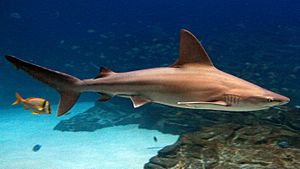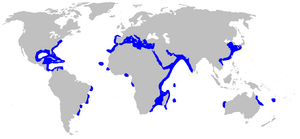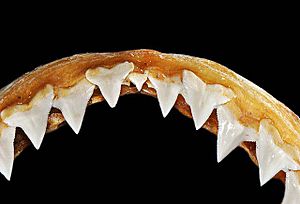Sandbar shark facts for kids
Quick facts for kids Sandbar shark |
|
|---|---|
 |
|
| Conservation status | |
| Scientific classification | |
| Genus: |
Carcharhinus
|
| Species: |
plumbeus
|
 |
|
| Range of the sandbar shark | |
The sandbar shark (Carcharhinus plumbeus) is a type of shark that lives in the Atlantic Ocean and the Indo-Pacific region. It's known for its tall first back fin and a ridge between its two back fins. Don't mix it up with the sand tiger shark, which has a similar name but is a different kind of shark!
Contents
What Does a Sandbar Shark Look Like?
The sandbar shark is also called the thickskin shark or brown shark. It is one of the biggest sharks found near coastlines. It is related to other large sharks like the dusky shark and the bull shark.
Sandbar sharks have strong bodies and a rounded snout that is shorter than many other sharks. Their first back fin is triangular and very tall. They also have long pectoral fins, which are like arms. Their upper teeth are uneven with sharp edges, perfect for catching prey.
Female sandbar sharks become adults around 13 years old. They are about 155 centimeters (about 5 feet) long from their nose to the fork in their tail. Males become adults around 12 years old and are about 152 centimeters (about 5 feet) long. Females can grow up to 2.5 meters (8.2 feet) long, while males can reach about 1.8 meters (5.9 feet).
Their skin color can be bluish-grey, brownish-grey, or even bronze. Their underside is usually white or pale. Sandbar sharks can swim alone, or they might gather in groups. These groups often have only males or only females.
Where Do Sandbar Sharks Live?
Sandbar sharks love to live in shallow coastal waters. You can find them over muddy or sandy bottoms in places like bays, estuaries (where rivers meet the sea), harbors, and river mouths. They can also swim in deeper waters, sometimes more than 200 meters (650 feet) deep.
These sharks live in warm and mild waters all over the world. In the western Atlantic Ocean, they are found from Massachusetts down to Brazil. Young sandbar sharks often grow up in special areas called "nursery grounds." Important nursery grounds are found in places like the lower Chesapeake Bay, Delaware Bay, South Carolina, the Florida Keys, and even Boncuk Bay in Turkey.
What Do Sandbar Sharks Eat?
Sandbar sharks are predators, meaning they hunt other animals for food. They mostly eat fish, rays, and crabs.
Sometimes, sandbar sharks can become prey themselves. Larger sharks like the tiger shark might hunt them. Very rarely, a great white shark might also prey on a sandbar shark.
Reproduction and Life Cycle
Sandbar sharks are viviparous. This means their babies grow inside the mother, getting food and oxygen from a special connection like a human baby.
Female sandbar sharks usually have babies every two or three years. They lay their eggs in early summer. After carrying their babies for about one year, they give birth to an average of eight pups. Sandbar sharks can live for a long time, typically between 35 and 41 years.
Sandbar Sharks and Humans
Are Sandbar Sharks Dangerous to People?
Even though sandbar sharks are large and look a bit like other dangerous sharks (like bull sharks), they are generally not considered a threat to humans. There have been very few, if any, attacks linked to sandbar sharks. This makes them one of the safer sharks to swim near. Because of this, they are also popular sharks to see in aquariums.
Fishing and Conservation
In the past, many sandbar sharks were caught by fishing boats. This was because their fins were valuable. However, due to concerns about overfishing, the U.S. government banned commercial fishing for sandbar sharks in 2008. This was done to help protect their numbers.
Today, only a small number of special boats are allowed to fish for sandbar sharks. They do this for scientific research, helping experts learn more about these sharks. An independent researcher must be on board these boats to make sure everything is done correctly.
The New Zealand Department of Conservation has listed the sandbar shark as "Data Deficient." This means they don't have enough information yet to know exactly how many sandbar sharks are in their waters.
See also
 In Spanish: Tiburón Trozo para niños
In Spanish: Tiburón Trozo para niños





